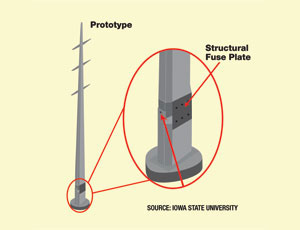Earthquakes, wind and ice can make electric service transmission poles topple like dominoes, costing millions of dollars to replace.

Jon Rouse, a civil engineering professor at Iowa State University, hopes to eliminate that cost by incorporating hinges into the base of poles to deflect stress and bounce the poles back—like Weebles, the 1970s toys that “wobble but don’t fall down.”
Currently, the industry relies on sturdy and costly “dead-end structures” every five to 10 miles to block poles from cascading. Rouse’s 110-kv poles, now being tested at the university, eliminate the need for dead ends and prevent even single poles from falling. A single pole can cost more than $45,000 to replace.
In Rouse’s design, the hollow, steel power-line poles—up to 12 ft in diameter and up to 150 ft tall—are attached to a short base by a hinge pin oriented to let the pole bend when loaded parallel to the lines. Sacrificial steel plates connect the pole and the base, and under normal loading, these plates keep the pole upright.
“If the structure wants to rotate about the hinge, it will cause stress in the plates,” Rouse explains. “The plates in compression are intended to buckle, and the second plate on the tension face is designed to stretch.” Only the plates need replacing if the poles are subject to a high-stress event.
Rouse plans to place post-tensioning tendon cables in the poles for another resistant component. “Think of them as rubber bands,” he says. “The farther the structure deflects, the more the strands resist.”
Nathan Mitchell, director of electric reliability standards and compliance with the American Public Power Association, calls Rouse’s design “interesting and innovative,” saying “Any way of saving money on the cost of building [the poles]—but keeping the same reliability and safety aspects in mind—is the important part.”
div id="articleExtras"

Post a comment to this article
Report Abusive Comment